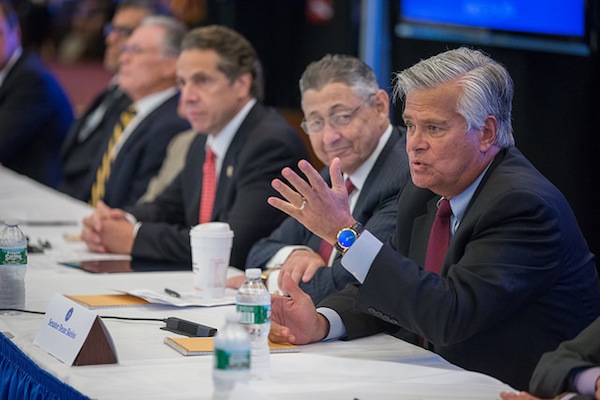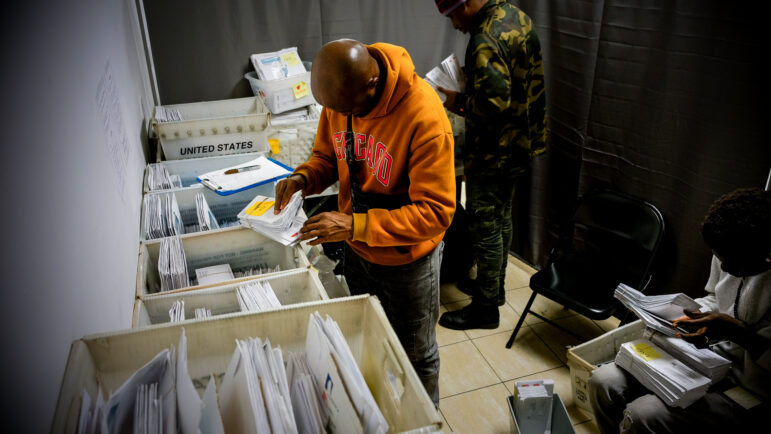
Photo by: Office of the Governor
Gov. Cuomo, Speaker Silver and Senate Republican leader Skelos will likely hold the keys to achieving RAFA’s wish list of housing policy changes.
Late last month a coalition of 50 groups, including housing, labor, health, environment and immigration rights advocates, marched in Harlem to call on Mayor Bill de Blasio and other city and state officials to prioritize affordable housing in New York.
As hundreds of its members chanted “Fight, fight, fight… housing is a right,” during the August 20 march from First Corinthian Baptist Church to the Harlem State Office Building, Real Affordability for All (RAFA)—the city’s largest and most diverse affordable housing coalition—was escalating its effort to make housing a primary focus of every candidate in the 2014 statewide elections.
“We understand that we have to take all this energy that we are building up to Albany,” said Jaron Benjamin, executive director of the Met Council on Housing.
With almost half of the city living near the poverty line, advocates say that New York is facing its worst housing crisis in recent decades. In April, RAFA proposed a detailed plan to the mayor, calling for a 50-50 housing model where half of the new apartments in rezoned areas will be set aside for moderate-income people and lower-income families.
Now the coalition hopes to gain wider support from the mayor and the City Council to lobby the state legislature for policies to create and preserve affordable housing. How it will maintain unity once the campaign gives way to the nitty-gritty of policymaking remains to be seen.
As the city continues to lose affordable housing – 385,000 units from 2002 to 2011 according to RAFA’s 50-50 proposal – organizers stress the urgency of getting housing reform on the radar of all elected officials.
Making connections
RAFA’s approach is to find broad connections between different groups to address the housing crisis on multiple levels.
Organizers are working on one such connection between labor and housing. “It is a false dichotomy to think of issues separately,” said Patrick Purcell Jr., executive director of GNY LECET, a trust fund for trade unions and contractors in New York. “Our members don’t only exist in the work place. Our members exist as mothers and fathers. And our members exist as people who need housing. And our members exist in the same way every New York City resident exists wanting a safe job, a safe place to live and safe schools.”
Purcell explained that GNY LECET supports RAFA because housing alone cannot be sustainable without jobs. And when contractors exploit workers by committing fraud—paying in cash to avoid worker’s compensation, unemployment insurance and taxes—it affects everyone.
“It’s not just the worker who is not getting paid right,” said Purcell. “When you have groups of workers who are not getting health insurance on that site… [it causes] a widespread ripple that affects the tax payer, our economy, our healthcare, our social services.”
Other RAFA organizers are similarly looking for solutions in connecting issues. “Housing equals healthcare,” said Jeremy Saunders, lead organizer for VOCAL-NY, an organization that works with marginalized communities. “We know through data that homelessness takes days off the lives of people living with AIDS. We know firsthand that housing for people with AIDS means you can take medication, you can stay healthy.”
Saunders emphasized that good housing promotes good habits. But when you are homeless, instability aggravates your health. “People who are homeless are not as able to make decisions that reduce health factors, and are less capable of taking care of any health issue that they are dealing with – from HIV to diabetes,” he said. Now, with 54,000 homeless New Yorkers, VOCAL-NY has teamed up with RAFA to call for city-state rental assistance programs that will protect people’s homes and health.
Some healthcare organizers have also found connections between health management, housing and the environment. “We saw firsthand [through hurricane Sandy] how the environment exacerbates health conditions brought upon by the deterioration of housing and infrastructure,” said Ogonnaya Dotson Newman, director of environmental health for WE ACT, an environmental justice organization based in northern Manhattan.
Newman explained that when heat, water and electricity breakdown in homes, they can become triggers for asthma, heart disease, depression and stress, among other health issues. And when landlords try to evict tenants, they often fail to make repairs that have direct consequences on health.
Coalition challenges
For RAFA organizers, the August 20 march was the first step in a long-term campaign. “Last week [referring to the march] was all about showing that we are united and have tied the needs of each of our members to one another,” said Saunders.
RAFA’s upcoming events include a series of town hall meetings that aim to educate and empower New Yorkers to defend their communities against unfair development. The coalition will also mobilize against subsidized housing projects that offer low number of affordable units and refuse to hire union wage workers.
While RAFA’s organizing strategy is both new and innovative, some of its members have been working together on different issues for years. And the roots of their collaboration can be found in horizontal movements like Occupy Wall Street, which also rallied different groups to address both social and economic inequality.
Now, RAFA faces similar challenges like Occupy did after being evicted from their Zuccotti Park encampment in lower Manhattan: They need to find ways to maintain unity and impact.
Saunders acknowledged that focusing on isolated issues could divide communities and groups separated by competing interests. But by addressing housing from multiple perspectives, he said, the coalition has so far reinforced the idea that every issue affects us as a community.
Changes to rent regs sought
The coalition will present its state legislative platform in the fall.
But RAFA organizations like Make the Road New York—a nonprofit that offers community outreach for housing, immigration, employment and other issues—have been meeting with state legislators to work on strategies for pending housing legislation.
Luis Enriquez, supervising attorney for Make the Road, said that coalition members want to repeal vacancy decontrol—a law that allows landlords to deregulate rent stabilized apartments as soon as their rents reach $2,500 and over—and eliminate vacancy bonuses and rent hikes tied to major capital improvements, which are being used by landlords to push stabilized rents up.
RAFA is also calling upon Albany to improve the 421-a tax exemption program, which lowers property taxes to incentivize development, so that it can mandate more affordable units. This recommendation is consistent with the coalition’s 50-50 proposal, which outlines similar policy changes to finance affordable housing.
The plan got the endorsement of some City Council members, though de Blasio’s affordable housing plan did not embrace the 50-50 model. Critics say that the 50-50 proposal won’t work because more market rate apartments are needed to make affordable housing sustainable. They also point out that the Urstadt Law and other state regulations, which empower the state to control rent stabilization and tax abatements, will be major obstacles in getting new housing money and policy changes from Albany.
But RAFA organizers explain that the model is flexible, and they are looking for a middle ground where housing and other issues can be addressed as a community. They also agree with critics that market-rate apartments, which are often seen as a threat to community interests, can be used to “offset the cost of building affordable.”
RAFA organizers emphasize that the solution to the housing crisis depends on all New Yorkers. “Civic engagement needs to become part of everyday life,” said Benjamin from Met Council on Housing. “We cannot afford to defer political responsibilities.”








